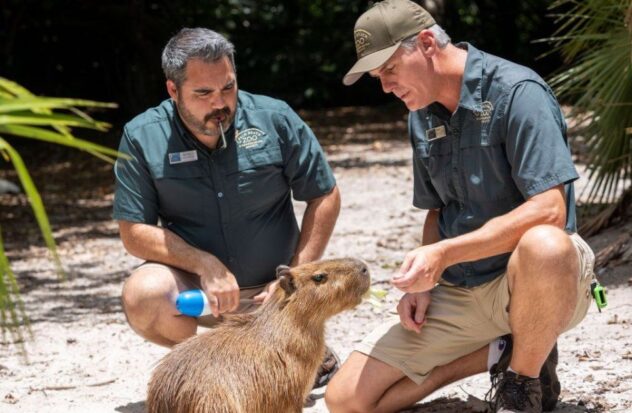WEST PALM BEACH — A female capybara arrived at a zoo in Florida as part of a breeding program to increase the population of these large South American rodents.
Iyari, a 10-month-old capybara, arrived at Palm Beach Zoo & Conservation Society in May from the San Diego Zoo Wildlife Alliance. He’s in a mixed-species habitat with a pair of Baird’s tapirs, who live in similar habitats in South America, as zoo workers slowly introduce him to Zeus, the park’s 2-year-old male capybara.
“We think there’s a little love in the air,” said Mike Terrell, general curator of the Palm Beach Zoo. “Every time they look at each other from afar, we see that look in their eyes of, ‘Hey, I want to spend a little more time with you.’ So right now everything is very positive.”
Iyari’s move to South Florida began at the recommendation of the Association of Zoos and Aquariums (AZA). The organization manages the entire population of capybaras and other animals at each AZA facility, with the understanding that the animals’ genetics could contribute to wild populations in the future.
Capybara gestation lasts about five months, with an average litter of four individuals. Palm Beach Zoo officials don’t know when they will be able to have cubs. According to Terrell, everything will depend on how long it takes Iyari and Zeus to meet.
Capybaras are the species They are the largest rodent in the world and look like giant guinea pigs. They live in savannahs and dense forests near bodies of water. They are a sociable species that usually live in groups of about 10 individuals, although sometimes they can reach 100.
They are herbivores and not endangered, but Terrell noted that these “ecosystem engineers” eat plants and keep waterways clean so other animals can live in them.
“They are critical to their ecosystem,” Terrell said.
Visitors to the Palm Beach Zoo can see Iyari in the Tropics of America section of the park. This 23-acre (9-hectare) park in West Palm Beach is home to hundreds of animals, many of them endangered.
Source: With information from AP




